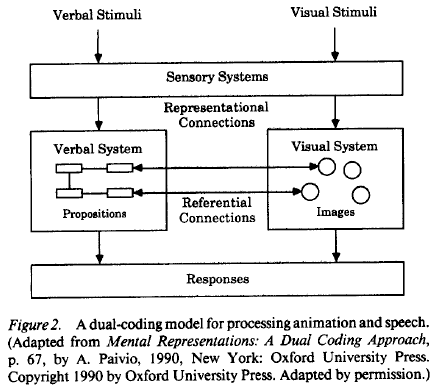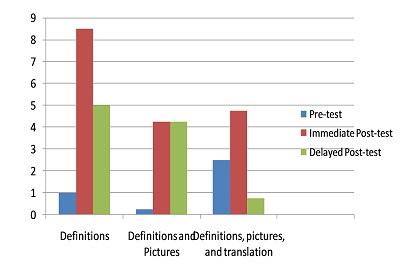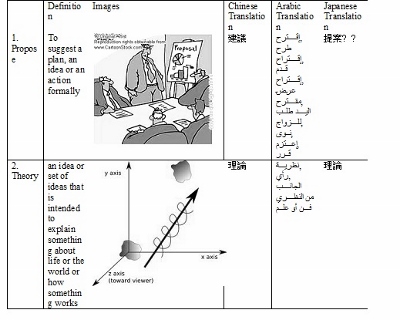|

Alice Chan
|
|

Maria Petkova
|
Vocabulary acquisition is the backbone of second language
learning. If a student uses the correct words with the wrong grammar, he
or she will probably still be able to convey the message (Folse, 2004).
Therefore, students and teachers of ESL or EFL are constantly searching
for the best ways to learn vocabulary faster and retain it in long-term
memory. Definitions, pictures, and translations are three of the most
common ways to present and practice unfamiliar vocabulary. Definitions
in the target language are very popular in ESL teaching, pictures are
widespread in children’s or beginners’ classes, and translation is
heavily relied on in many EFL settings. The present study aimed to test
and compare the effectiveness of these three techniques, with the
assumption that all three of them would produce optimal learning effects
if applied at the same time.
Paivio’s Dual Coding Model
Paivio’s (2006) dual coding theory suggests that nonverbal
stimuli, such as pictures and images, support verbal memory, including
bilingual memorization of vocabulary. The stimuli enter the brain’s
processing systems along two parallel channels, which, however, may also
compete with each other (see Figure 1):

Figure 1. The two parallel channels of Paivio’s (2006) Dual
Coding Model.
Kroll’s Bilingual Model
Kroll’s (1993) bilingual model represents the different ways in
which less fluent and more fluent second language speakers access
concepts through their native or second language. It can be seen from
Figure 2 that more concepts are easily accessible through the native
language, and this happens especially at low or intermediate levels of
second language proficiency:

Figure 2. Kroll's (1993) Bilingual Model
According to the models in Figures 1 and 2, images and using
the native language can help students learn vocabulary and retain it in
their long-term memory. This study examined how memory works in
vocabulary acquisition, in particular, and whether definitions alone or
when accompanied with images and translations better aid intermediate
ESL learners in remembering English vocabulary. A quasi-experimental
research design exposed the same class of 19 high-intermediate intensive
English program students (Chinese, Arabic, and Japanese) in the United
States to three different vocabulary treatments—the first explained and
practiced vocabulary using definitions only; the second definitions and
pictures; and the third definitions, pictures, and translations. The
means and standard deviations of participants’ pretest, immediate
posttest, and delayed posttest scores were compared to find out if a
combination of definitions, pictures, and translations would be the most
effective way to present and practice new vocabulary.
Research Questions
Are there significant differences in the effectiveness of
teaching vocabulary using definitions only; definitions and pictures; or
definitions, pictures, and translation?
Are there significant differences in the short-term and
long-term retention of vocabulary taught using definitions only;
definitions and pictures; or definitions, pictures, and translation?
Procedures
Pretests
Immediately before each treatment, the students were asked to
complete, individually, a crossword puzzle consisting of 10
level-appropriate target vocabulary items and three or four distractor
words, which were not part of the target vocabulary list (see Appendix
A).
Treatment
The above-mentioned class (listening and note-taking class) met
twice a week, on Tuesday and Thursday for 75 minutes. During three
consecutive weeks, every Tuesday the students received one of three
different types of treatments (see Appendix B): the first presenting and practicing
vocabulary in context with definitions; the second adding images to the
context and definitions; and the third adding translation to the
context, definitions, and pictures. The target vocabulary words,
definitions, pictures, and translations were cut up into cards and the
students matched them, working in groups of three or four. The teacher
walked around the room, observing the students as they participated in
their groups. She answered students’ questions and provided
clarifications and explanations to help students identify the correct
pictures and translations when necessary. This activity was seen as presentation of new vocabulary, so the
teacher helped a lot, but also let some students who already knew or had
guessed the meanings of new words explain them to their group. The
practice context consisted of academic lectures including the target
vocabulary. After the matching activity, the class listened to a
recorded lecture containing the vocabulary, took notes, and answered
comprehension questions.
Immediate Posttests
Two days after each treatment, on Thursdays, students were
asked to complete a different crossword puzzle consisting of the target
vocabulary.
Delayed posttests
Three weeks after each treatment, students were asked to
complete yet another crossword puzzle containing the target vocabulary.
They were told it was a review that would not be graded.
Data Analysis
The scores of the nine tests (three pretests, three immediate
posttests, and three delayed posttests) were tabulated for each of the
19 participants. Mean scores and standard deviations were calculated for
each test. The scores were also entered in the statistical software
program PASW, Predictive Analysis Software (formerly known
as SPSS, Statistical Package for the Social Sciences) and a one-way repeated
measures ANOVA, Analysis of Variance, as performed to
see if there were significant differences among the different
treatments and the timing of the tests.
Results
The nine tests that the students took before and after each of
the three treatments (teaching 10 vocabulary items explained first only
in definitions; then, teaching 10 different vocabulary items with
definitions and pictures; and finally, teaching 10 more vocabulary items
using definitions, pictures, and translations in matching activities)
were scored. The mean scores and standard deviations for all tests and
treatments are presented in Table 1and Figure 3.
Table 1. Test Results
|
Definitions |
Definitions and Pictures |
Definitions, Pictures, and Translations |
|
Mean |
Standard Deviation |
Mean |
Standard Deviation |
Mean |
Standard Deviation |
|
Pretest |
1.00 |
0.82 |
0.25 |
0.50 |
2.50 |
0.58 |
|
Immediate Posttest |
8.50 |
1.73 |
4.25 |
3.10 |
4.75 |
3.69 |
|
Delayed Posttest |
5.00 |
2.16 |
4.25 |
2.87 |
0.75 |
0.50 |
As can be seen from Table 1, the students generally did not
know most of the three sets of 10 target words before they were first
introduced in class, as the mean scores of all three pretests are very
low, between 0.25 and 2.50, with relatively low standard deviations,
between 0.50 and 0.82. Surprisingly, the best scores on the immediate
posttests, with a mean score of 8.50 and the low standard deviation of
1.73, were achieved after using only definitions in English to teach the
new vocabulary. When definitions and pictures were combined, the mean
score on the immediate posttest was much lower at 4.25, with a higher
standard deviation of 3.10, similar to when definitions, pictures, and
translation were presented simultaneously (mean score 4.75 on the
immediate posttest with standard deviation of 3.69). On the delayed
posttests, the students also did better when vocabulary was taught using
only English definitions, even though they forgot many of the words
they knew on the immediate posttest, as the mean score went down to 5.00
with standard deviation of 2.16. The use of definitions and pictures
together yielded a slightly lower mean score of 4.25 on the delayed
posttest, with standard deviation of 2.87. However, the application of
definitions, pictures, and translations together resulted in the lowest
delayed posttest score of 0.75, which is lower even than the pretest,
before any teaching had occurred. (See the bar graph in Figure 3 for a
better visual representation of the results).

Figure 3. Test Results
A repeated-measures one-way ANOVA was run in PSAW statistical
software. The results were computed using alpha = 0.05. As for the
treatment, there were no significant differences among the effectiveness
of the three treatments (sig = 0.297) but for the second factor, time,
there were significant differences among the scores on the pretests,
immediate posttests, and the delayed posttests (sig = 0.037).
Discussion
The results of the tests for the first and second vocabulary
sets show a pattern. Students got the highest scores in the immediate
posttests and the lowest scores in the pretest. The scores for the
delayed posttests were lower than the immediate posttests but higher
than the pretests. This pattern was expected, because students should be
able to remember more words immediately after the treatment. Two weeks
after the treatment, students forgot some of the words learned, as they
did not revise or do any practice with the words between the treatment
and the delayed posttest.
However, the test results of vocabulary list 3 show a different
pattern. The students still got the best results for the immediate
posttest, but did worse in the delayed posttest. The mean score of the
delayed posttest was very low (0.47), much lower than the pretest
(1.38). Many of the test papers were turned in blank. One student
received two points, and nobody scored higher than that. In the pretest,
three students were able to obtain three points, which was the highest
score. As for the number of students who got zeros, there were five in
the pretest but ten in the posttest.
In general, the overall results contradicted the hypothesis
that vocabulary is learned more effectively with images and
translations. The students performed better in both posttests for word
list 1, which was taught with definitions only. The students continued
to do badly in the following tests, which show that the images and
translations did not help them to learn the words. On the contrary, it
appears that they even had adverse effects on students’ vocabulary
learning.
As Paivio’s (2006) dual coding model might suggest, perhaps the
pictures and the definitions, which were both in print, competed for
the students’ attention. Pictures may also be confusing, especially for
more abstract words: for instance if a smiley face is used to illustrate
the word happy, students might think that it means smile. The use of pictures, however, seemed to help
improve long-term memory as the results of this particular immediate
posttest and delayed posttest were almost exactly the same. In other
words, the students did not learn more words with pictures and
definitions than with definitions alone, but whatever they learned
seemed to stay in long-term memory without any further practice.
Therefore, pictures may be helpful only after the meaning of a new word
has already been clarified in a different way, and then a supplementary
image association may aid memory and long-term retention.
On the other hand, when translations were added to the
definitions and pictures, the students did the worst. One possible
reason could be that they were matching words in their native language
to images, as one student reported doing, completely leaving out the
English vocabulary and definitions. Again, perhaps the three different
techniques again competed for the students’ attention and cognitively
overloaded them. Translation may be a good, efficient technique on its
own, but not combined with definitions in the target language and
pictures at the same time.
Conclusion
In conclusion, simpler and shorter explanations seemed to be
the best formula for successful vocabulary acquisition. Certainly more
research is needed in this most fundamental, indispensable, and to some
extent neglected area of second and foreign language learning.
REFERENCES
Folse, K. (2004). Vocabulary myths: Applying second
language research to classroom teaching. Ann Arbor: The
University of Michigan Press.
Kroll, J. F. (1993). Accessing conceptual representations for
words in a second language. In R. Schreuder & B. Weltens (Eds.),The bilingual lexicon (pp. 54–81). Amsterdam/
Philadelphia: John Benjamins.
Paivio, A. (2006). Mind and its evolution: A dual
coding theoretical interpretation. Mahwah, NJ: Lawrence
Erlbaum Associates.
Dr. Alice Chan has been teaching English as a second
language for more than 10 years in Hong Kong and the United States of
America. Her research interest is in idiom instruction.
Dr. Maria Petkova has been learning and teaching English as a
foreign and second language for more than 35 years in Bulgaria, the
United Arab Emirates, and the United States of America. Her research
interests focus primarily on vocabulary and pragmatic
competence.
Appendix A
Sample Crossword Puzzle Test (click to enlarge)

Appendix B
Sample Treatment Material (click to enlarge)

|

